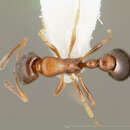en
names in breadcrumbs


Although the precise native range of C. mauritanica is not known, its close relationship to the East Asian C. kagutsuchi and inability to penetrate that species range (Seifert, 2003) suggested C. mauritanica might be of West Asian or Eastern Palearctic descent. The species has commonly been misidentified as C. nuda across the Palearctic, and has been referred to by its junior synonym C. ectopia in North America (Seifert, 2003). The Californian C. mauritanica population was most probably introduced from the W Palaearctic via the Atlantic islands, the Caribbean and the southern states of the USA (Seifert, 2003).
Cardiocondyla mauritanica has been the subject of several ecological studies in southern California (Creighton & Snelling, 1974; Gulmahamad, 1997). Gulmahamad (1997 )observed the species as a diurnal year-round forager when temperatures exceeded 18.9 degrees C. Foragers mostly took nectar, but also preyed on small insects and scavenged. It nested in small cavities in mortar, cracks and expansion joints in concrete, and in soil. An excavated colony yielded 322 individuals (the most ever published for a Cardiocondyla species at the time of the study). It was also capable of living in sympatry with L. humile, possibly by producing a potent chemical repellent.
Snelling (in Creighton & Snelling, 1974) made his observations from a single polydomous colony whose nest entrances were situated between bricks set into the soil, fully exposed, and marked by piles of debris. He found foragers traveled at least 6 m. from the nest in search of food, though they were very reluctant to take any of the baits offered. The species was often foraged by tandem running in group of two or three. The excavation of one nest yielded eight dealate females, two alate females, about 75 workers, and two males. Snelling also observed the mating between one of the males and one of the alate females. The apparent absence of alate males in this species and the presence of ergatoid males in the particular nest strongly suggest these gynes to be inseminated and to disperse for nest foundation (Heinze et al., 1993).
Native range. Old World, probably Eurasia.
Current range includes. Canary Islands,Madeira, S Portugal, S Spain, Morocco, Tunisia, Libya, Malta, Egypt, Greece, Ukraine, Turkey, Israel, Jordan, Iraq, Iran, United Arab Emirates, Abu Dhabi, Oman, Afghanistan, Pakistan, N India, Nepal, Zimbabwe, Puerto Rico, Arizona, California, Texas.
Among introduced Cardiocondyla species, C. mauritanica (together with C. mauritanica, C. minutior, and C. venustula) is differentiated from C. emeryi, C. obscurior and C. wroughtonii by (1) its weakly impressed to absent metanotal groove; (2) short propodeal spines that are reduced to right angles (those of C. minutior are of moderate length); and (3) a postpetiole that is lower than the petiole and lacking a distinct ventral bulge. Cardiocondyla kagutsuchi and C. mauritanica are separated from C. venustula by the more angulate postpetiolar sides, which in dorsal view give the postpetiolar disc a hexagonal appearance. Separating the former two species is difficult, and the reader is referred to Seifert (2003), who writes that C. mauritanica can be separated from C. kagutsuchi by it shorter spines, lower petiole, narrower postpetiole, longer scape and longer gaster pubescence.
Diagnosis among workers of introduced and commonly intercepted ants in the United States. Worker caste monomorphic. Head shape subrectangular. Antenna 12-segmented. Antennal club 3-segmented. Antennal scapes easily extended beyond eye level but scapes do not extend beyond posterior margin of head. Antennal scrobe lacking. Antennal insertion not surrounded by a raised sharp-edged ridge. Eyes greater than 5 facets; not unusually large (distinctly less than half head length). Posterolateral corners of head unarmed, without spines. Mandibles triangular. Mesosoma lacking erect hairs. Metanotal groove absent to shallow; not distinctly impressed. Pronotal spines absent. Propodeal spines short. Slope of mesosoma gradual. Waist 2-segmented. Petiole with a distinct and upright node; lacking large subpetiolar process. Petiolar peduncle long (length distinctly twice or more than height); does not taper gradually into node. Postpetiole appearing swollen. In dorsal view postpetiole wider than long and much broader than petiole; with gently rounded anterolateral corners; sides angulate giving the postpetiolar disc a hexagonal appearance. Postpetiole lower than petiole and lacking a distinct ventral bulge. Upper surface of gaster attached to postpetiole. Color variable. Typically, dorsal head dark brown, mesosoma and waist orange brown, gaster dark to blackish brown. Lighter brown or, on the other hand, concolorous blackish brown samples may locally occur throughout the range.
Cardiocondyla mauritanica is a small (~ 2 mm), nondescript, light brown to blackish brown species with short antennal scapes, propodeal spines reduced to small angles and without erect hairs on its mesosoma. The species is a highly successful tramp ant (Heinze et al., 2006)and is one of the most abundant and most widely distributed Cardiocondyla species of the world, preferring semi-deserts and other xerothermous habitats (Seifert, 2003). Despite its success at invading new habitats, C. mauritanica remains an inconspicuous member of the ant fauna across its range, and is not reported to cause harm to either humans or native species. Cardiocondyla mauritanica is known to be polydomous and polygynous and founds new colonies preferentially by nest splitting (Seifert, 2003).
Taxonomic history
Forel, 1901j PDF: 378 (q.); Forel, 1904d PDF: 6 (ergatoid m.).Subspecies of Cardiocondyla nuda: Forel, 1901j PDF: 378.Raised to species: Ortiz & Tinaut, 1987 PDF: 32.Senior synonym of Cardiocondyla emeryi nitida: Bernard, 1956c PDF: 305.Senior synonym of Cardiocondyla ectopia: Seifert, 2003a PDF: 248.Senior synonym of Cardiocondyla caparica: Henin et al., 2003 PDF: 377.I [introduced species]
(1, w; 3, w, q; 11, w; 20, w; 38, w; 41, w, q). From 20 to 570 m, open dry habitats.
69 samples with 138 workers from Afghanistan, Egypt, Greece, India, Indonesia, Iran, Iraq, Israel, Jordan, Kiribati, Libya, Malta, Morocco, Oman, Puerto Rico, Pakistan, Portugal, Spain, Tunisia, Turkey, United Arab Emirates, Ukraine, and USA (Arizona, California, Florida).
Cardiocondyla mauritanica is a species of ant in the family Formicidae.[1][2][3][4][5]